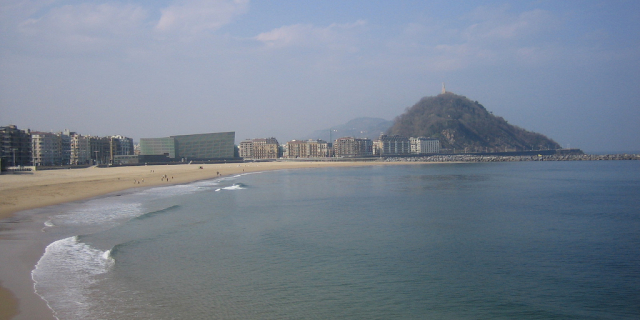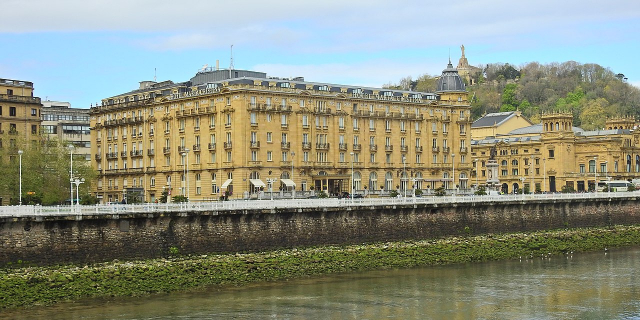Ainhoa
( Ainhoa, Pyrénées-Atlantiques )Ainhoa (French pronunciation: [ajnɔa]; Basque: Ainhoa) is a commune in the Pyrénées-Atlantiques department in the Nouvelle-Aquitaine region in southwestern France.
The ancient redoubt of Urrizti reflects the ancient past of the area.
From the 13th to 17th CenturiesPaul Raymond noted on page 4 of his 1863 dictionary that the parish of Ainhoa was in the gift of the Abbot of Urdax (Spain).[1] The Curacy of Ainhoa was created by the Priory of the Premonstratensian of Urdazubi in the 13th century.
On 27 April 1238 the new king Theobald I of Navarre purchased the toll rights formerly instituted by Viscount Juan Pérez de Baztan, Ainhoa being then at the borders between the Duchy of Aquitaine since 1151, run by the Angevin Kings of England and the Navarrese kingdom.
Such tolls were charged to pilgrims and traders traveling to Santiago de Compostela on the Way of St. James in Galicia, Spain. Military clashes between the "English run" Basques of Aquitaine and the Navarrese in 1249 led the Seigneur of Ainhoa, in 1250, to recognize the suzerainty of King Henry III of England. By 1265 Gonzalvo Juanis, Seigneur of Ainhoa, also known as Gonzalvo Ibáñez or Gonzalvo Yáñes, did not recognize either the English or the Navarrese. However he died in 1289 and opened the way to conquest based on old historical claims. Then, Garda Arnaut de Espelette, with loyalty to the "English run" Basques of the Duchy of Aquitaine, sent a letter, dated 29 July 1289 praying the Ainhoa people to adequately connive with him. The outcome of such frontier business was to set up an "undivided" land as had been done also previously with the nearby Aldudes close to the Baztan valley.
Documents from Estella dated September 1369, some 80 years later, proved that the people from Ainhoa paid taxes to both the King of Navarre and the "English" Seneschal of the Landes territory in return for their fiscal and personal privileges.
When "English run" Bayonne surrendered to the French in 1451 it is not known if these "undivided status" villages on the English-Navarrese frontier were taken by the French as well.
In the Spanish Invasion of 1636 in the Labourd territories many villages, including Ainhoa, were razed. Later, probably because of the 1659 "Treaty of the Pyrénées" whereby the Spanish-born Queen regent of France Anne of Austria with the help of Cardinal Mazarin, the First Minister of France, set up an advantageous (for the French) peace and also obtained Maria Theresa of Spain as a wife for her son Louis XIV of France. Ainhoa was then repopulated again.
Disputes between the new settlers and the old residents concerning the use of communal lands for cattle grazing and fodder and the access by newcomers to town hall positions, schooling, church grants, etc. had to be settled by the then autonomous Parliament of Bordeaux in the sense of paying for access to village privileges.
Ainhoa was destroyed during the Thirty Years War (1618-1648) and then rebuilt. The only remains from before the destruction are the church and the Machitorénéa House.
The 18th centuryIn 1724, following the revolts in Saint-Jean-le-Vieux (1685) Mouguerre and Saint-Pierre-d'Irube (1696), the people of Ainhoa revolted against the salt tax and against other new taxes. This was a prelude to the uprisings in all of Labourd in 1726 against the said taxes. Bayonne and Saint-Jean-Pied-de-Port followed in 1748.[2]
The Law of 4 March 1790[3] determined a new administrative landscape of France by creating departments and districts. This resulted in the creation of the department of Basses-Pyrénées and reuniting the Béarn, the Gascon lands of Bayonne and Bidache, and the three French Basque provinces. For the latter, three districts were created: Mauleon, Saint-Palais, and Ustaritz which replaced the Bailiwick of Labourd. The seat of Ustaritz was transferred almost immediately to Bayonne. Its Director persuaded a large number of municipalities to adopt new names conforming to the spirit of the Revolution. So Ainhoa was called Mendiarte, Ustaritz became Marat-sur-Nive, Itxassou became Union, Arbonne became Constante, Saint-Étienne-de-Baïgorry became Thermopyles, Saint-Palais became Mont-Bidouze, Louhossoa became Montagne-sur-Nive, Saint-Jean-Pied-de-Port became Nive-Franche, Saint-Jean-de-Luz became Chauvin-Dragon (the name of a young soldier killed in action), and Souraïde became Mendialde.
In 1794, at the height of the Terror and after the desertion of forty seven young people from Itxassou, the Committee of Public Safety (Decree of 13 Ventôse Year II - 3 March 1794) arrested and deported some of the inhabitants (men, women and children) of Ainhoa, Ascain, Espelette, Itxassou, Sare, and Souraïde and decreed that these communes like the other communes of the Spanish border were "infamous communes".[4] This was extended to Biriatou, Cambo-les-Bains, Larressore, Louhossoa, Mendionde, and Macaye.
The people were "united in various national houses, or in the district of Ustaritz or in the Great Redoubt, like Jean-Jacques Rousseau".[5] In reality, they were gathered together in churches and then deported in very precarious conditions[6] in Bayonne, Capbreton, Saint-Vincent-de-Tyrosse, and Ondres. The Departments where people from the communes were interned were the Lot, the Lot-et-Garonne, the Gers, the Landes, the Basses-Pyrenees (partly béarnaise), and Hautes-Pyrenees.
The return of exiles and the recovery of their possessions were determined by a series of decrees issued on 29 September and 1 October 1794, driven in this direction by the Director of Ustaritz who said: "The onetime communes of Sare, Itxassou, Ascain, Biriatou, and Serres, whose inhabitants were interned eight months ago as a measure of general safety, have not been improved. The people who come to obtain freedom to retire to their homes, clamour for food without my being able to procure the means to meet this primary human need, hunger.".[7] The recovery of their possessions was not without difficulty, they were placed in receivership but were not registered and were looted: "The property, movable and immovable, of the inhabitants of Sare, were neither recorded nor legally described, and all our furniture and household effects were removed and brought confusedly to neighbouring communes. Instead of being put in safe places, some were sold at auction and sometimes sold without auction.".[8]
19th-20th CenturiesDuring the retreat of the Napoleonic Army from Spain in 1813, Labourd villages were again submitted to abuse by the Confederate British and Spanish troops.
Under the German occupation of France during World War II many of these frontier villages were fully administered by the German military, but were also an escape route for British soldiers, French Resistance members, and European Jews trying to reach non-belligerent Spain.




































Add new comment